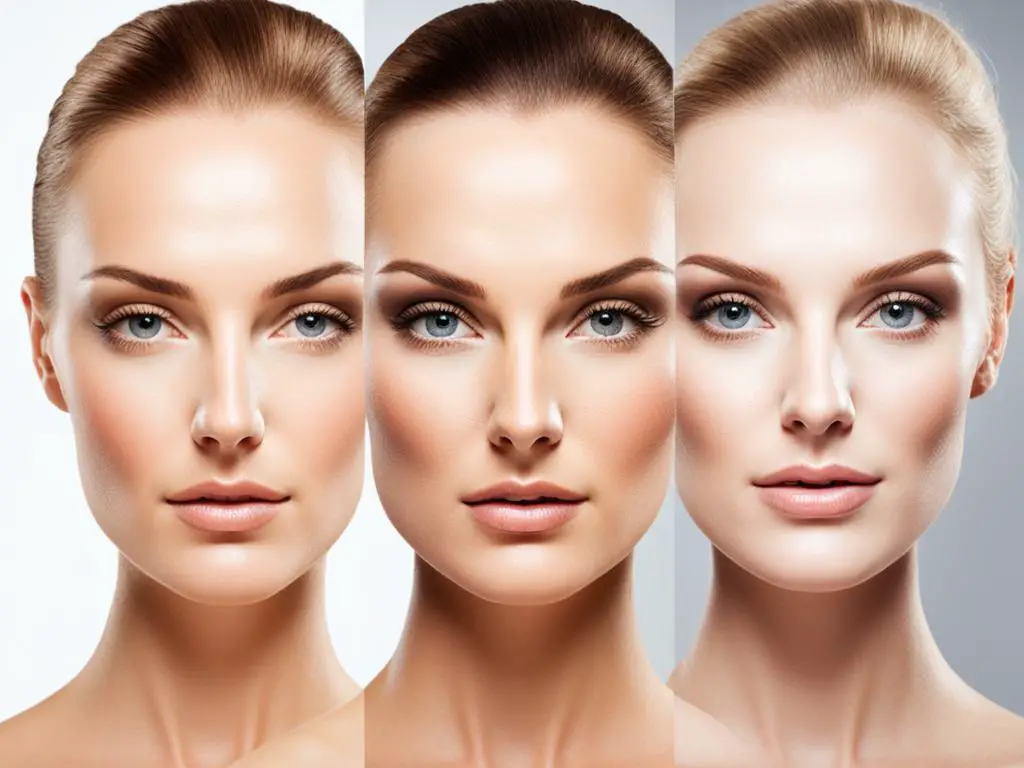When it comes to skin complexion, there has always been a debate between pale and tanned skin. Society often associates tanned skin with health, vitality, and beauty, while pale skin is sometimes considered less desirable. But is there any truth to these beauty myths? In this article, we will uncover the differences between pale and tanned skin, explore the benefits of pale skin, and highlight the risks associated with tanning. We will also provide essential skincare tips for both types of complexions, so you can achieve a radiant and healthy glow.
Key Takeaways:
- Pale skin has its own unique beauty and elegance, debunking the myth that only tanned skin is attractive.
- Tanned skin can come with risks, including premature aging, sunspots, and an increased risk of skin cancer.
- Proper skincare routines and sun protection are essential for maintaining the health and radiance of both pale and tanned skin.
- Societal beauty standards have evolved over time, and it’s important to celebrate and accept the unique qualities of all skin types.
- Regardless of your complexion, healthy and radiant skin can be achieved by following a consistent skincare regimen and protecting yourself from the sun.
Understanding Pale Skin
When it comes to beauty standards, pale skin has often been associated with elegance and allure. Despite societal pressures to achieve a bronzed complexion, pale skin possesses its own unique charm and benefits.
“Pale skin is like a blank canvas, ready to be highlighted and accentuated.”
Contrary to the popular belief that tanned skin is superior, pale skin has its own set of advantages. One of the main benefits is its ability to highlight and enhance other features. Makeup effortlessly stands out on fair skin, allowing for endless possibilities in creating different looks.
Moreover, pale skin tends to age more gracefully than tanned skin. The risk of developing fine lines, wrinkles, and sunspots is comparatively lower, making it easier to maintain a youthful appearance. Additionally, individuals with pale skin are less prone to hyperpigmentation, which can often be a concern for those with tanned or darker complexions.
But achieving and maintaining the beauty of pale skin requires diligence and care. Sun protection becomes paramount, as fair skin is often more susceptible to sunburn and damage. The importance of wearing sunscreen with a high SPF cannot be emphasized enough, especially when spending extended periods outdoors.
Caring for pale skin also involves adopting a consistent skincare routine. Gentle cleansers, moisturizers, and exfoliants can help maintain the skin’s natural radiance while addressing specific concerns like dryness or sensitivity. The use of products containing antioxidants and lightening agents can aid in brightening the complexion and reducing any unevenness.
Skincare Tips for Pale Skin:
- Apply sunscreen with a broad-spectrum SPF of 30 or higher every day, even during cloudy weather.
- Wear protective clothing, such as hats and long sleeves, to shield the skin from harmful UV rays.
- Choose skincare products specifically formulated for pale skin, focusing on hydration and protection.
- Exfoliate regularly to remove dead skin cells and promote a clear, glowing complexion.
- Use a moisturizer that suits your skin type to provide essential hydration and maintain skin health.
In conclusion, pale skin should be celebrated for its unique beauty and the benefits it offers. By understanding its characteristics and implementing proper care, individuals with fair complexions can achieve a healthy, radiant glow that stands out in a sea of tanned skin.

Unraveling Tanned Skin
Tanned skin is often coveted for its sun-kissed glow and the perception of health and vitality it conveys. However, it’s important to understand the risks associated with excessive tanning and the potential harm it can cause to your skin.

Exposing your skin to prolonged periods of sun exposure without proper protection can lead to a range of issues. One of the primary risks is the harmful effects of UV radiation, which can penetrate the skin and cause various problems.
UV radiation can accelerate the aging process, resulting in premature wrinkles, fine lines, and sagging skin. It can also contribute to the development of sunspots, dark spots, and discoloration, which can be challenging to treat and diminish the overall appearance of your skin.
“Protecting your skin from UV radiation is crucial in maintaining its overall health and appearance. Prevention is better than cure when it comes to tanning,” says Dr. Maria Gonzalez, a dermatologist at Skincare Clinic.
Furthermore, excessive tanning increases the risk of developing skin cancer, including melanoma, the deadliest form of skin cancer. According to the American Cancer Society, regular exposure to UV radiation through tanning beds or the sun significantly raises the chances of developing skin cancer.
To care for your tanned skin and minimize these risks, it’s essential to prioritize sun protection. Start by wearing broad-spectrum sunscreen with a high SPF every day, even during cloudy or winter months. Reapply it every two hours and seek shade during peak sun hours.
- Choose clothing that covers your skin and offers additional sun protection.
- Wear a wide-brimmed hat and sunglasses to shield your face and eyes from harmful rays.
- Hydrate your skin with moisturizers and after-sun products to help soothe and nourish it after sun exposure.
- Consider using self-tanning products or spray tans as a safer alternative to achieve a bronze complexion without the risks of UV exposure.
By implementing these precautions and taking the necessary steps to care for your tanned skin, you can enjoy a radiant, healthy glow while protecting yourself from potential harm.
Pale vs Tanned Skin: Understanding the Differences
When it comes to skin tones, there’s a perpetual debate between pale and tanned skin. In this section, we will explore the physical and cultural distinctions between these two complexions. Understanding these differences can help us appreciate and celebrate the unique qualities of both pale and tanned skin.
Physically, pale skin is characterized by its light tone, often accompanied by cool undertones. On the other hand, tanned skin has a warm, sun-kissed glow resulting from increased melanin production when exposed to UV radiation.
From a cultural perspective, beauty standards have drastically evolved over time. In ancient civilizations, pale skin was associated with social status, as it indicated a life of leisure and wealth. Today, however, tanned skin is often considered more desirable due to its association with health, outdoor activities, and the pursuit of a sun-kissed complexion.
Media influences play a significant role in shaping these perceptions. Advertisements and popular culture often portray tanned skin as the epitome of beauty, reinforcing the notion that a sun-kissed glow is the ideal standard. However, it’s essential to recognize that beauty is subjective, and the appeal of pale or tanned skin ultimately depends on personal preferences and cultural backgrounds.
The true beauty of pale and tanned skin lies in embracing and accepting our individuality, rather than conforming to societal norms.
To further understand the differences between pale and tanned skin, let’s take a closer look at some notable characteristics:
| Pale Skin | Tanned Skin |
|---|---|
| Light complexion | Sun-kissed glow |
| Cool undertones | Warm undertones |
| Higher risk of sunburn | Increased natural sun protection |
| More prone to freckles and sunspots | Reduced risk of skin damage |
As seen in the table above, both pale and tanned skin have distinct qualities. Pale skin is more susceptible to sunburn and skin damage, making proper sun protection crucial. Tanned skin, on the other hand, provides natural sun protection and is less prone to sunburn, but it’s important to note that excessive exposure to the sun can still lead to skin issues.

By appreciating and understanding the differences between pale and tanned skin, we can foster inclusivity and challenge the notion that one complexion is superior to the other. Embracing our unique characteristics allows us to cultivate a diverse and accepting society.
Conclusion
In this article, we have debunked the beauty myths surrounding pale and tanned skin, highlighting the unique qualities and benefits of each. We have emphasized the importance of understanding and celebrating both pale and tanned skin, rather than adhering to societal beauty standards.
Regardless of your complexion, proper skincare is essential for maintaining radiant and healthy skin. For pale skin, it is crucial to protect yourself from the sun’s harmful UV rays by applying sunscreen with a high SPF, wearing protective clothing, and seeking shade during peak hours. Additionally, incorporating a moisturizer and gentle cleanser into your skincare routine can help keep your skin hydrated and fresh.
For tanned skin, it is important to remember that even with a tan, your skin is still vulnerable to sun damage. Applying sunscreen and using after-sun products can help soothe and nourish your skin. Hydrating your skin with a moisturizer and exfoliating regularly can also help maintain a healthy glow.
By following these skincare tips for both pale and tanned skin, you can ensure that your complexion stays healthy, radiant, and well-nurtured. Embrace your unique skin tone and take care of it with love and attention, as it is a reflection of your inner beauty.
